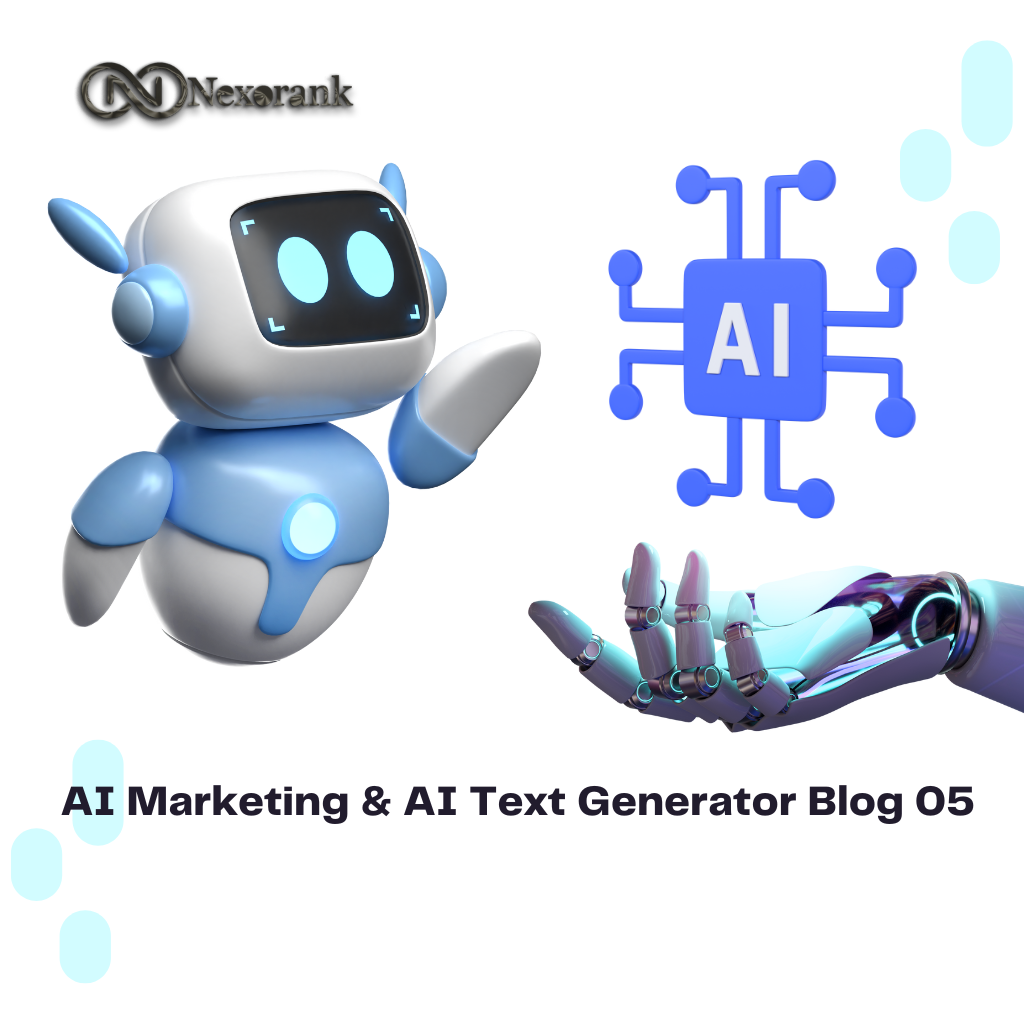Artificial Intelligence tools such as ChatGPT, Claude, Writer, and Bard have become true game-changers in the world of content generation. But what’s a powerful ally if you’re not quite sure how to harness its capabilities? AI represents the paradigm shift, but understanding how to craft effective prompts? That’s the ace up your sleeve, the key to unlocking the full potential of this cutting-edge technology.ai text generator
What are AI prompts?
Prompts are the input that people give the AI to set the direction for the content it generates. Prompts themselves are just natural language, in other words, the regular speech patterns that humans use in everyday communications. But there’s skill in developing effective prompts that shape the quality of AI-generated outputs.
Kipp Bodnar, Chief Marketing Officer, HubSpot
When you’re thinking about prompting any AI tool, what you want to do is be specific and detailed. The worst prompts are prompts that are overly simple, because you’re just going to go back and forth, that you’re not going to really get anywhere. The best prompts are going to be very, very specific. Think of it like a creative brief for a robot. So think about what to tell it. Who you’re trying to talk to, what you’re trying to accomplish what your goal is, what your constraints are, how much money you have, how much time you have, those, the types of information that are really going to make it provide an answer that is not just strong and something you can use, but custom and relevant just specifically to you. And that’s one of the things AI is truly great at. Instead of giving you a broad, general answer, giving you an answer that is specific to you in your business.
Crafting effective prompts is just one part of harnessing the full potential of AI for content creation. To truly unlock the power of these new technologies, prompt engineering should be incorporated into a larger framework that involves planning the purpose and goals, understanding the target audience, iterating based on reviewing outputs, and refining prompts over time. With the right framework, even simple prompts can drive sophisticated results, while a lack of strategy risks wasting AI’s potential. Following a process enables you to shape prompts strategically, making sure they elicit content that aligns with your goals and resonates with your audience. Rather than treating prompts as one-off tasks, integrating them into a thoughtful workflow enables the prompt crafting skills to become a force multiplier, amplifying the value of your AI tools. Bycontextualizing prompts within a larger process, you can transform AI from a novel toy into a strategic asset for your goals.
Josh Blyskal, AI solutions architect, HubSpot suggests you need to think of a few things before you begin prompting.
The most important thing to consider when you’re creating your prompts for your AI tool is to know your use case, what are you defining? What are you starting? What problem do you have? Defining the problem is probably the single most essential part of building a really good prompt. You might want a certain output, but without understanding the problem, the AI can’t give that to you. We set the ultimate goal as prompters, prompt engineers, whatever we want to call ourselves. And it’s up to us to communicate that goal to teach the AI how to give us the success we’re looking for. It wants to help and the number one thing we can do is let it do that. So building in frameworks, thinking about problems, you know, broken down [in a] piece by piece way, is my number one advice. Just explain it. And when in doubt, write it out. That’s what I recommend.
To help with this, we’ve developed a framework with a handy-to-remember acronym called DICE to enable marketers to transform their AI workflows into strategic assets for enhancing customer experience, increasing engagement, and driving conversions.
Let’s explore the DICE framework.
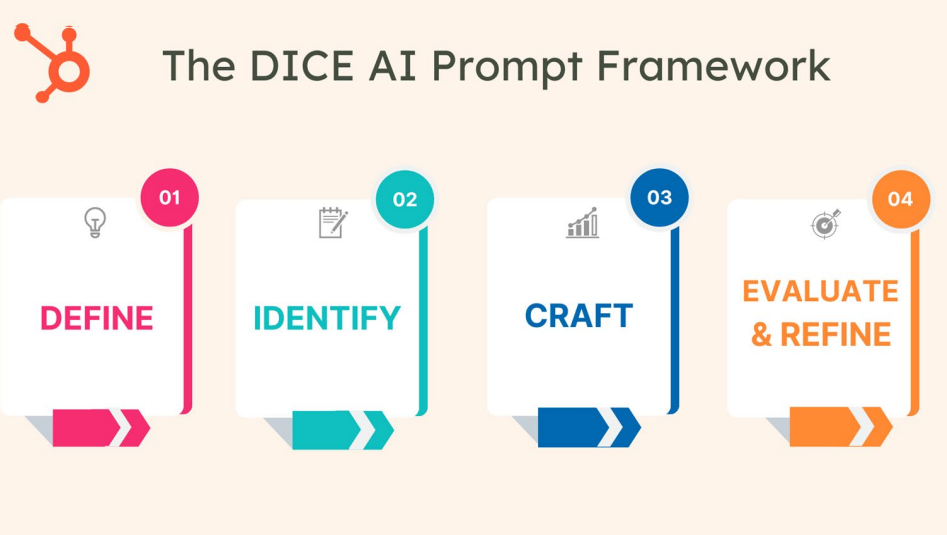
First, Define. What do you want the AT to do? Do you want the AT to generate content,
answer questions, offer recommendations, or something else? Clarifying your goals at this stage will help when you begin crafting your prompts.
Next, Identify. Consider your audience. Use your understanding of your established buyer persona to shape your AI prompts. This helps make sure the AI’s responses align with your audience’s context, enhancing relevance and engagement.
Then, Craft. This step involves crafting the actual prompt. It’s important to be explicit and clear. If the prompt is too vague, the AI might not produce the desired results. Experiment with different formulations and see which ones work best.
Finally, Evaluate and refine. Assess the AI’s reply. If unsatisfactory, revisit your goal, context, and prompt. The AI learns from training data patterns, not prior interactions, so reiterate necessary information as needed.
For easy access, you’ll find a downloadable.pdf of this framework in the resources section.
Here’s an example marketing scenario showing the DICE framework for AI prompting:
Define: The goal is to generate social media content ideas to promote a new line of organic skincare products.
Identify: The target audience is environmentally conscious millennials interested in natural beauty and wellness.
Craft: “I need content ideas for Instagram and Facebook to market our new organic skincare line to environmentally conscious millennials. The product line is vegan, uses renewable materials for packaging, and contains no harmful chemicals. Please suggest eight creative and engaging social media post titles that would appeal to this demographic’s values around sustainability and natural products.”
Evaluate: Review the AI’s suggested social media content ideas. Provide feedback to refine them based on how well they align with the brand identity and how closely they resonate with the target audience. Perhaps some of the ideas offered by the AI don’t resonate. In this case you could ask: “The suggested post ’10 Ways Our Skincare Helps You Have an Instagram-Ready Face” seems off-brand for us. Can you suggest something focused more on the natural ingredients we use instead?” Reiterate important context as needed until the output matches the marketing objective for your audience.
So now you have the overall framework to use when working with AI tools. But when it comes to the “crafting” part of the framework, using specific prompting methods can result in more precise and valuable outputs. There are a variety of prompting methods you can use to develop better outcomes. One thing to note is that the answers to some of these prompts are quite lengthy. To make reviewing them easier, you can download a text copy of the prompts and their results from the resources section.
Now, let’s dive deeper into each method.
One thing to note is that the answers to some of these prompts are quite lengthy. To make it easier, you can download a text copy of the prompts and the results for review. You’ll find that document in the resources section.
1. Comprehensive Prompting
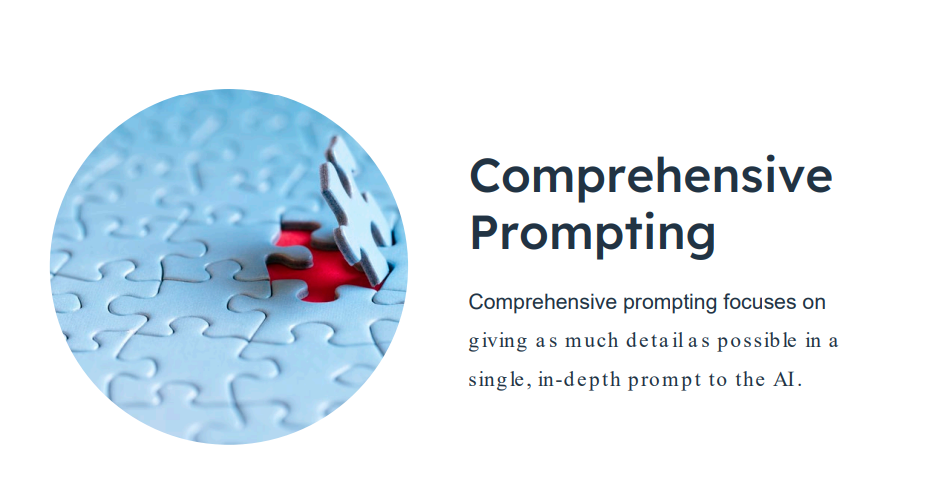
Comprehensive prompting focuses on giving as much detail as possible in a single, in-depth prompt to the AI. This method is more effective for complex tasks where the AI needs full context about the goals and requirements in order to generate high-quality results. The idea is to provide all relevant information up front rather than relying on the AI to piece it together through multiple iterative prompts. By laying out the complete picture in a single prompt, you enable the AI to produce output that fully aligns with your objectives from the start.
Let’s see what this looks like in action. Here is an example prompt: “We need a comprehensive blog post for our B2B audience about the benefits of cloud-based CRM systems. The post should cover the cost savings, scalability, ease of access, increased collaboration, and enhanced customer insights that these systems offer. Include real-world case studies, potential challenges and how to overcome them, and a conclusion that reinforces the advantages. Keep the tone informative and professional.” There were several case studies included in the AI output. This is where the “Evaluate” stage of DICE comes in. Make sure to double check all facts and details.
2. Iterative Prompting
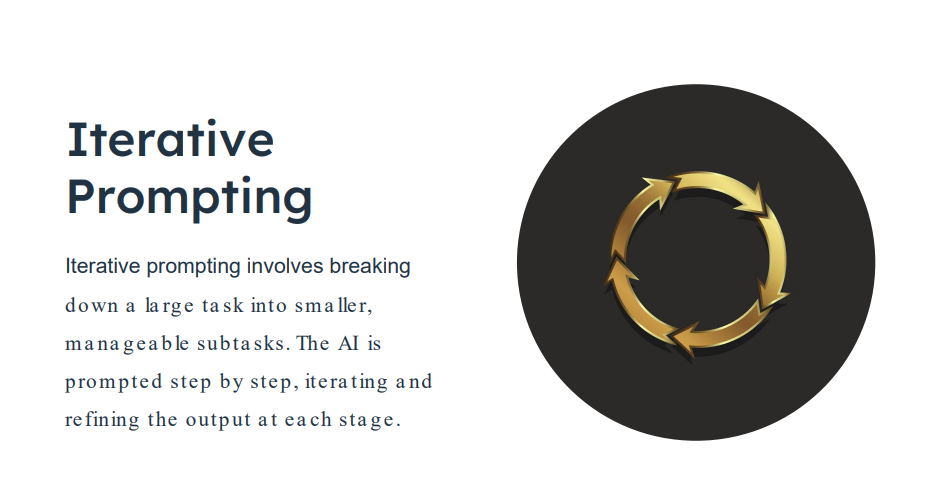
Iterative prompting involves breaking down a large task into smaller, manageable subtasks. The AI is prompted step by step, iterating and refining the output at each stage. This method works well when tasks are multifaceted or need a higher level of creativity and originality.
Here’s an example: “Create an engaging email campaign to promote our B2C fashion brand’s summer collection. First, we need a catchy subject line that will encourage customers to open the email. Next, write a compelling introductory paragraph that highlights the uniqueness of our summer collection. Then, describe a few key pieces from the collection, and finally, craft a strong call-to-action that incentivizes readers to check out the new collection on our website.”
Of course, if you were creating a similar prompt for your own business, you’d supply the AI with the right information to tailor the products and call-to-action to fit your needs.
3. Layered Prompting
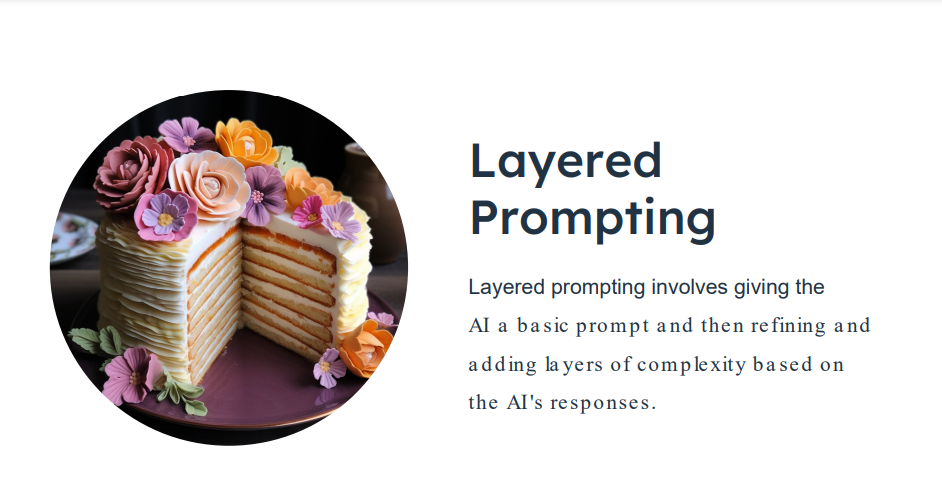
Layered prompting involves giving the AI a basic prompt and then refining and adding layers of complexity based on the AI’s responses. This could involve added instructions, examples, or context, which can guide the AI to a more nuanced and detailed output.
Let’s use the example of a B2C marketer developing a new line of eco-friendly clothing.
The first prompt might be:
“List current popular trends in the eco-friendly fashion industry.” The AI generates a list of trends. Then you add a layer. Pick a trend and ask, “What are the key elements that make this trend appealing to consumers?” The AI describes why consumers are attracted to this trend.
Then you might ask “What types of clothing items are most often associated with this trend?” The AI then offers a list of clothing items linked to this trend.
Based on the items listed, you might ask, “What design features could we incorporate to create a new clothing line that fits this trend, while keeping our brand’s sustainability commitment?” The AI then suggests design features for your new eco-friendly clothing line.
As you can see, each prompt builds on the AI’s previous response, guiding it towards a more detailed and nuanced output.
HubSpot AI Solutions Architect, Josh Blyskal, is a fan of these three prompts: So if you asked me which one or two prompting methods I would use, and all my prompts, or which prompting method is best overall, I’d say that’s a really hard question to answer, because so many of these different methods and so many of these different ideas are so situationally based. Now if I had to pick one that I thought is the most essential, and underpins everything that prompting is about, I’d probably say comprehensive prompting is the number one thing you can do, just as someone starting out. Even for me, I find it difficult to remember to give AI all the information that I want to give it. Sometimes I fall short, and the output definitely shows I have to remember, “Give it the full detail. Tell it exactly what your problem is. Tell it the information. Tell it what you want to achieve. It wants to help you.” When I do that, I find my outputs increase in quality drastically.
Iterative prompting is amazing as well.
When we get that conversation going with the model, when we start first with our problem and let it ask questions or build on itself, or narrow down to exactly what we want to make our satisfaction, our quality, the feel of that output is going to increase all the time. The more you can train the AI back, the more it’s going to be able to help you.
Now, I also love layered prompting. You know, when we have a super difficult, prompt like, “Write me an entire novel.” AI can’t do that yet. Open AI can’t do that …ChatGPT… Cloud. All these fantastic, awesome services that’s just still too complicated of an ask. But with your layered prompt you can do so much more. You can break it down. Write me an outline. Tell me what happens in each chapter. Start from the beginning, right? I love using these, especially in those scenarios and tons more. It’s all about adapting and improvising, honestly.
There are a number of other prompts that can help you generate great content.
4. Feedback Loop Prompting
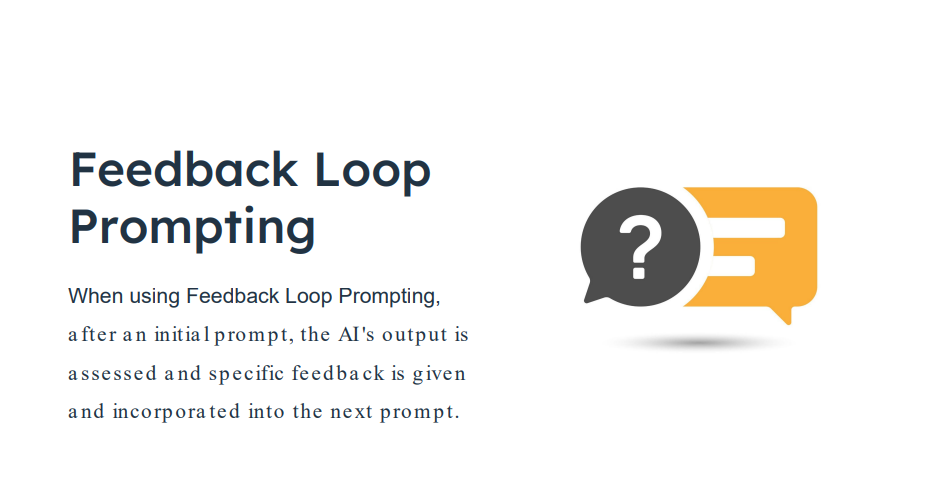
When using Feedback Loop Prompting, after an initial prompt, the AI’s output is assessed and specific feedback is given and incorporated into the next prompt. This feedback might involve adjustments to tone, style, content focus, or error correction. This iterative process, when repeated a few times, can significantly improve the quality of the final output.
For example, your first prompt might be: “Let’s create a product description for a new eco-friendly cleaning product in our online store. Start with a basic description.”
After the AI generates the description, you could provide feedback like, “The description is good, but can we make it more exciting and really emphasize the eco-friendly aspects? Also, add a bit about how effective the product is compared to traditional cleaning products.” Feedback conversations with the AI tool can result in refinements that significantly improve the content you’re generating.
5. Guided Brainstorming
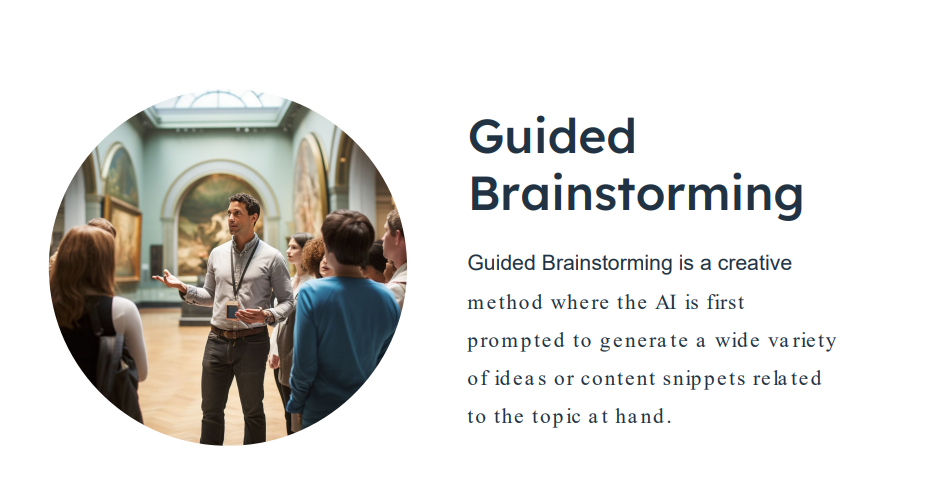
Guided Brainstorming is a creative method where the AI is first prompted to generate a wide variety of ideas or content snippets related to the topic at hand. Following this brainstorming, specific ideas are selected and further prompts are used to refine and develop these into full-fledged content. This method can help stimulate creativity and produce unique content.
You might start with a prompt, “Let’s brainstorm some blog post topics for our B2B marketing audience. The topics should focus on digital marketing trends, content creation, SEO strategies, and social media marketing.
After the AI generates a list of topics, select a few and ask the AI to develop a brief outline for each selected topic.
6. Parallel Prompting
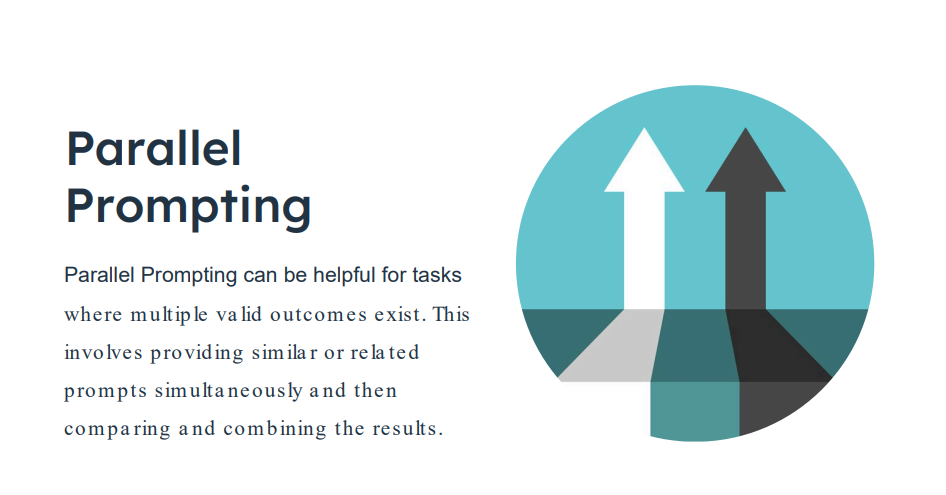
Parallel Prompting can be helpful for tasks where multiple valid outcomes exist. This involves providing similar or related prompts simultaneously and then comparing and combining the results. The best parts of each output can be combined to create a superior final product, or the different outputs could be used for A/B testing or variety.
Let’s say you’re a SaaS company trying to generate blog topics around the theme of ‘Remote Working.’
Start with the prompt “Generate five blog post titles that discuss the benefits of remote working for employees.”
After you receive the results, you ask it a different way: “Generate five blog post titles that explore the challenges of remote working for companies.”
And perhaps you try a third variation on the prompt: “Generate five blog post titles that offer solutions for common remote working problems.”
The AI will then produce a variety of blog post titles for each prompt. You can compare these suggestions and choose the ones that best align with your content strategy, or even mix and match to create new titles.
7. Flipped-Interaction Prompting
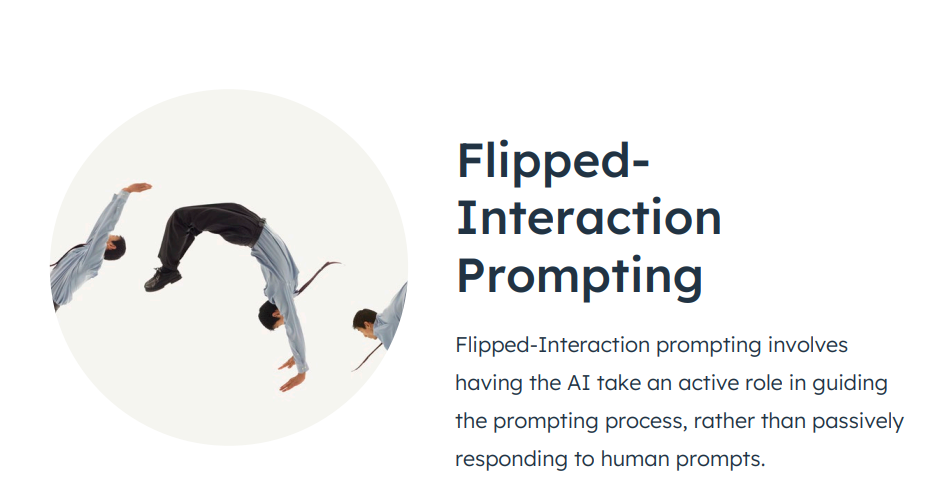
Flipped-Interaction prompting involves having the AI take an active role in guiding the prompting process, rather than passively responding to human prompts. Here’s an example of how that would work:
You start with the prompt: “I need you to act as a strategic marketing advisor and take the lead in developing an effective messaging brief for my new software aimed at small business owners. Rather than me giving lots of background details upfront, I’d like you to ask me a series of smart questions to understand who my buyer personas are, what they care about, who my competitors are, and what our unique value proposition is. Really probe to uncover any customer pain points or problems our product can solve. Once you feel you have a clear understanding of the product, market, and messaging goals, use your insights to develop a detailed messaging brief containing our value prop, positioning, recommended focus areas, and go-to-market strategy tailored to our audience. Let me know if you need any clarification on my responses to your questions as we go. Please start by asking me strategic questions to gather the information you need.”
Once you answer the questions, there may be a back and forth conversation with the AI tool to make sure it develops the best brief it can to meet your specific needs.
8. Alternative Approach Prompting
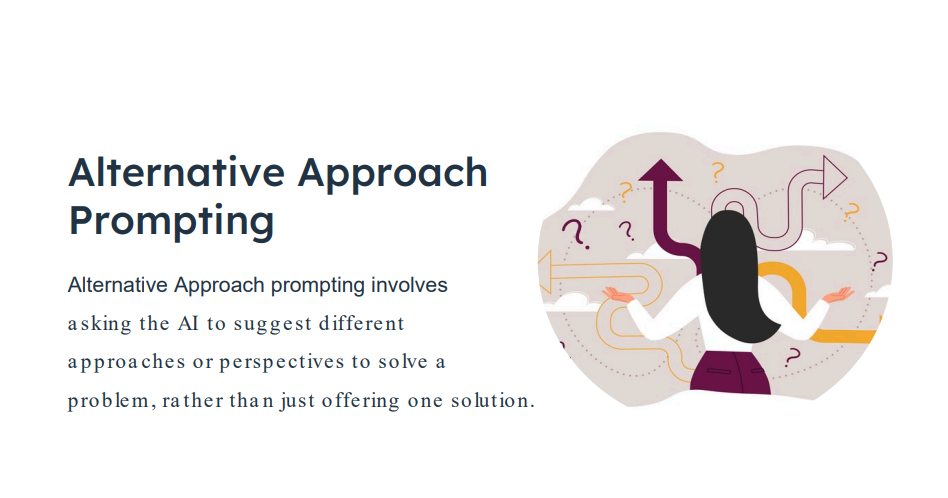
Alternative Approach prompting involves asking the AI to suggest different approaches or perspectives to solve a problem, rather than just offering one solution. This helps counteract cognitive biases where we may fixate on a specific approach even if it is suboptimal.
Alternative Approach prompting is a little more complex than the other types of prompts, so let’s go over the specific steps:
- Clearly define the problem statement or desired outcome, making sure that the AI understands the specific issue or goal you want to address.
- Explicitly ask the AI to provide alternative approaches to the problem, not just one solution, to encourage innovative thinking and diverse perspectives.
- Set parameters around the scope or constraints, but leave room for creativity by defining any necessary limitations while still allowing for outside-the-box thinking.
- Ask the AI to compare the pros and cons of each approach and recommend the best option(s), providing a comprehensive analysis that highlights the strengths and weaknesses of each alternative.
An example prompt could be:
“Within the scope of digital marketing campaigns, provide three alternative approaches we could take to achieve our goal of increasing brand awareness among young professionals. Outline the key elements of each approach, compare their pros and cons, and recommend which one or two approaches seem most likely to effectively reach our goal.”This encourages the AI to suggest fresh perspectives beyond the obvious, potentially revealing better solutions. Periodically using alternative approach prompting can counteract cognitive biases and lead to more innovative outcomes.ai text generator
Using these AI prompt frameworks and methods can dramatically enhance your marketing strategy and content creation process. With careful and effective prompting, AI can serve as an invaluable asset in your marketing toolkit, helping generate quality content tailored to your needs. Dive into your AI-powered marketing journey with finely crafted prompts, and steer your way to success.


